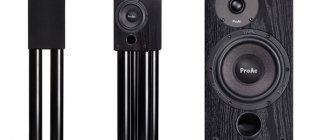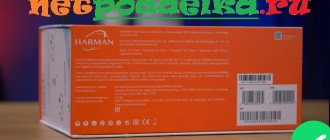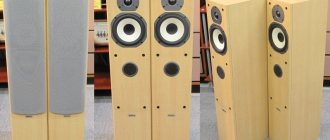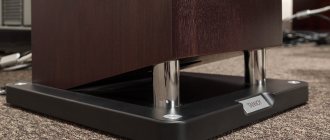PROAC STUDIO 140 MK2 - TEST OF FLOOR SPEAKER SYSTEMS
The Mk2 index in the name of the top model of the Studio series with number 140 indicates that this is the second version, an updated version of the floor standing speakers - in the same housings, but with new speakers and a crossover. The usual laconic classicism of forms and finishes for the ProAc company is also in place and is equally positively perceived, despite the lack of design tricks.
The rather narrow front panels of the Studio 140 Mk2 carry three speakers - a silk dome tweeter with a wide aluminum flange and a pair of midwoofers, in accordance with the usual 2.5-way design for ProAc. The manufacturer states that the dynamic heads used are new, developed according to its specifications by the Norwegian company SEAS specifically for this line. The midwoofer diffusers are made of polypropylene with the addition of carbon fiber to achieve both lightness, increased rigidity and good internal damping. Small hemispherical protective caps, called anti-resonance caps by the company, are made of very soft rubber.
Small floor-standing speakers look traditionally discreet, in the ProAc style - no rounded bodies or glossy varnish, only sharp edges and classic rectangular shapes. Black ash veneer under a matte finish has a beautiful natural texture and also looks restrained and laconic. The stands are made of 20 mm chipboard, veneered on top to match the cabinets. A fairly large bass reflex port with a plastic neck on the bottom of the body does not go into the podium, as in the older models of the company, but directly into the floor. A horn expanding hole is machined into the stand, which continues the cut of the port, so that the result is a cylindrical (constant cross-section) pipe with a horn collar at the outlet.
It’s a bit of a pity that in this model, for the sake of simplicity of design, the company refused to connect the port to the stand - this always has a beneficial effect on the sound, although in any case, the existing option is better than locating the bass reflex port on the rear wall. The most striking external detail is the two pairs of quality JA Michel I Engineering terminals for each speaker, with jumpers made of rhodium-plated brass studs. When unpacking the speakers, while they were upside down, through the hole in the bass reflex port, we were able to see the markings of the used midwoofers. They turned out to be from the SEAS Prestige series, with the number H1577-08 (P18RCY-C). There are also layers of white acoustic foam inside, laid along all four walls.
In direct contrast to the previous com test, the ProAc Studio 140 Mk2 pair seemed even a little matte, more restrained and calm, with a less open presentation. After the initial restructuring of perception to a different type of sound, I found a small tone-to-noise ratio, basic confidence in delivery, good information content and a clear separation of instrumental lines. The distinct structure of the lower register allows orchestral cellos and organ pedals to enter tightly and not blurred, quite recognizable; the kicks of drummers in rock also bring the necessary drive. The upper register is smooth and extended, without jewelry shine, but with a fairly pronounced attack. In terms of microdynamics, this model is inferior to its more expensive relatives (for example, the ProAc Response D28 we tested last year), but considering the price, everything looks pretty decent.
The orchestra is intelligible and generally coherent; in classical music, claims can only be made to a certain linearity of presentation, which does not dominate or obscure the meaning of what is being performed, but is still present. When playing rock and metal, the speakers noticeably come to life and play the proposed recordings vividly, energetically and as if even with increased volume. It cannot be said (as has already happened in this test) that the acoustics are entirely optimized for popular genres, including metal, but still they are somewhat more sympathetic to rock and drive than to multifaceted complex compositions.
TEST OF FLOOR SPEAKER SYSTEMS (category up to RUB 140,000)
When purchasing something as large and noticeable in the room as floor-standing speakers, one is often guided not only by the technical parameters and sound, but also by the appearance of the speakers. Stylish beauties in piano lacquer or exclusive veneer compete with modest ones made with an emphasis on functionality, and there is no absolute right choice in favor of external or “internal”. What has been said does not mean that we switch from analyzing design solutions and assessing sound to determining the degree of attractiveness of components, for which any flaws will be forgiven. And yet, let’s not lie - often the choice is made not only with the ears, but also with the eyes, and the excellent finish and thoughtful design of a potential acquisition are for many strong arguments in favor of the purchase. It’s hard to blame people for this - by nature, the visual component is the most important for us. Of course, a lover of high-quality sound with sufficient experience and experience in his audio hobby will easily prefer a simple and discreet (but correctly and functionally made) device or acoustics to bright, glamorous models. But even the most die-hard audio purists are not completely free from the forgivable pleasure of contemplating a beautifully made exquisite thing. In this “voting with their eyes” test, the participants were divided into two equal parts - three very beautiful designer couples and three with a simpler appearance. Moreover, the results in terms of design and sound turned out to be ambiguous in both cases.
A separate feature of the comparison was the used set of electronics (mainly an integrated amplifier) from the French company StormAudio. The design highlight of the mentioned device is the ability to smoothly adjust the output resistance for optimal matching with different loads. The test showed the real usefulness and necessity of such an option, and at the same time somewhat weakened the classical claim made against the very ideology of comparative tests. Critics of this genre of auditory examination often repeat that an approach built around identical listening conditions has not only obvious systemic advantages, but also equally obvious disadvantages associated with the impossibility of optimal selection of the environment for the tested components, as a result of which their signature and advantages are not revealed in to the fullest. Leaving aside a long conversation about testing methods and their correctness, I will still note that the presence of an amplifier like the StormAudio IA2.120, at a minimum, allows you to reduce or completely eliminate the problem of impedance matching, which can already be considered half the battle.
Test system 1 CD player - StormAudio CD 100 2 Integrated amplifier - StormAudio IA2.120 3 Interconnects and speaker cables - Analysis-Plus
Based on materials from Hi-Fi.ru
admin
See author's posts
ENTER THE SITE
The British company ProAc has a reputation for producing top-class speaker systems that combine excellent sound quality with an impeccable level of workmanship and external finishing. In appearance, ProAc speaker systems look quite traditional: the company's designers avoid newfangled solutions in external design. At the same time, behind the classic, one might even say conservative, appearance hides very interesting technologies aimed at achieving a balanced, detailed and extremely natural sound, for which ProAc speaker systems are valued all over the world.
The ProAc Studio 140 MKII floor-standing speaker systems are an updated version of the well-known Studio 140 floor-standing speakers, which have gained wide popularity among AV industry professionals and ordinary lovers of high-quality sound. However, calling the ProAc Studio 140 MKII simply an updated version is not entirely correct, since their design has undergone very serious changes compared to their predecessors.
ProAc Studio 140 MKII are slender floorstanding speakers with narrow front panels designed to minimize the impact of diffraction effects on playback quality. The task of transmitting low frequencies lies with two woofers with completely redesigned baskets and motor systems. The diaphragms of the woofers are made of polypropylene with the addition of carbon fibers. This combination makes it possible to achieve high rigidity and good internal damping parameters of the diffusers, avoiding the appearance of bending waves and associated sound distortions even at high volumes, as well as ensuring fast, accurate and dynamic sound of low frequencies due to the low mass of the diffusers. In order to enhance the sound of the lower bass, the ProAc Studio 140 MKII speakers have a bass reflex port with a port directed towards the floor. The task of reproducing high frequencies lies with the tweeter, equipped with a silk dome diaphragm, and having the same design as the tweeters used in much more expensive models of the company. It should be noted that both the woofers and tweeter are manufactured to ProAc specifications by the famous driver manufacturer SEAS.
To match the speakers, the ProAc Studio 140 MKII uses a specially designed crossover, manufactured using audiophile-grade components. The terminal panel for connecting speaker cables is taken from older Response models and allows for two-wire connection (bi-wiring/bi-amping).
Naturally, all the technical solutions implemented in the ProAc Studio 140 MKII by the development team of the English company led by Stuart Tyler could not but lead to a significant improvement in sound quality. ProAc Studio 140 MKII have exceptionally transparent, natural, but at the same time dynamic sound, excellent bass reproduction, including the lower bass range, and provide soft, but at the same time accurate transmission of high and mid frequencies.
Exclusive distributor of ProAc in Russia –
You are on a site of passionate people doing what they feel called to do. A creative approach and proven solutions are the key to the successful implementation of the challenges we face in the field of home and car audio/video, and protecting vehicles from theft.Through careful selection, we have chosen those brands whose products allow us to obtain the optimal solution (maximum quality for a certain price) in the above areas of our activity.
Home Audio/Video:
1. Selection, configuration, installation and configuration of home theater systems and stereo complexes .
2. Production of exclusive acoustic systems from various materials (MDF/veneer, natural wood, stone) according to individual projects.
3. Manufacturing racks for acoustics and equipment.
4. Repair, modification and reconfiguration (“tweak” in one word) of serial industrial acoustics.
Sound recording of commercial objects:
Integrated audio-video solutions for bars, restaurants, cafes, clubs, shopping centers, shops.
Warranty and post-warranty support.
Among the objects we have made (recently): the chain of establishments "Khlopok", the restaurant "Cruise" (1st and 2nd floors) on Shamora, the Lazurny shopping center-supermarket (Shamora), the D&B burger restaurant on Aleutskaya, a cafe-bar “Moonshine” on Svetlanskaya 1, the Chinese restaurant “Chinese Stories”, and much more...
car audio in Vladivostok precisely in the direction of high-quality music reproduction, and not emphasizing the quantitative (as most often happens) side of this topic.
You can get objective advice on issues of sound and car security from us.
List of works and services:
Sound in car:
1. Installation of speakers.
2. Noise/vibration insulation of doors (for installing speakers) and car interiors.
3. Making podiums for speakers in doors and on stands (under midrange and high frequencies)
4. Manufacturing of cabinet subwoofers.
5. Manufacturing of built-in (integrated into the interior) subwoofers (stealth).
6. Installation of head units.
7. Installation of amplifiers.
8. Complete refurbishment of the interior and individual parts.
Leather of German and Italian production. Alcantara.
9. Setting up audio/video systems.
Car security:
1. Installation of alarm systems at various levels.
2. Installation of immobilizers.
3. Tinting car windows.
4. Strengthening optics.
5.Installation of mechanical anti-theft systems Dragon and Mul-T-Lock locks.











